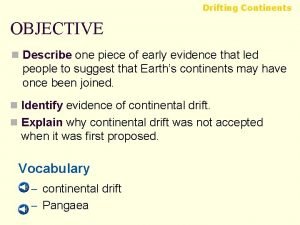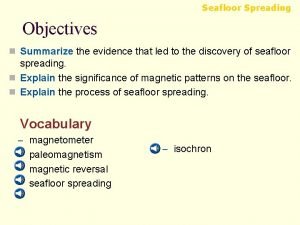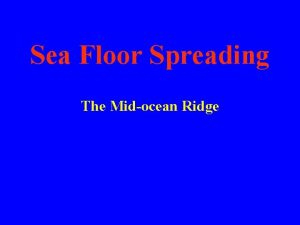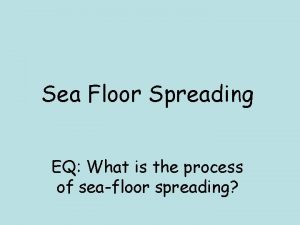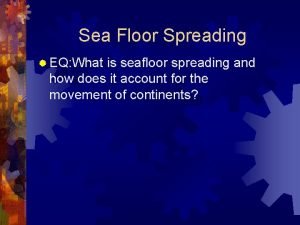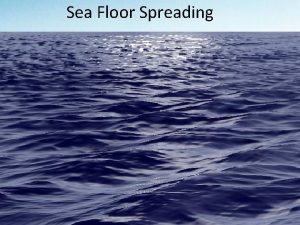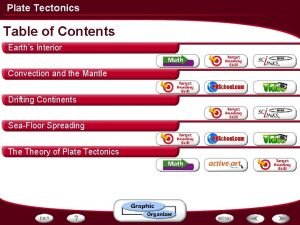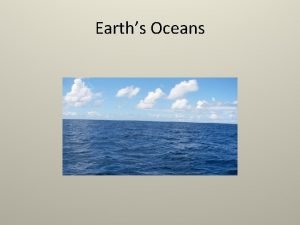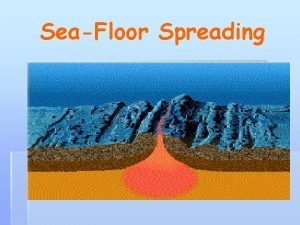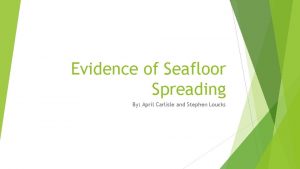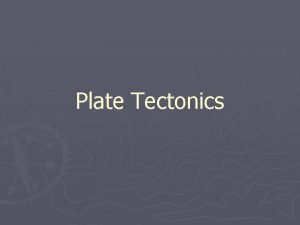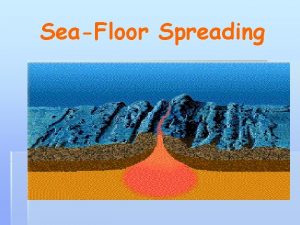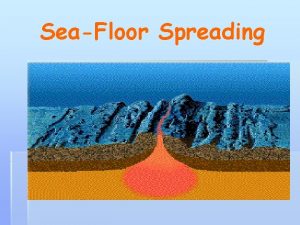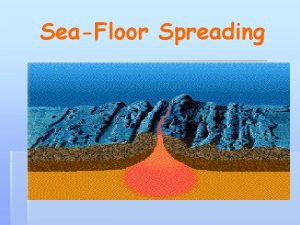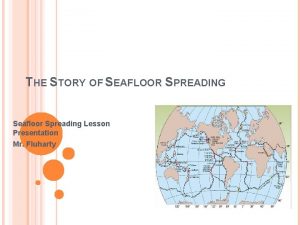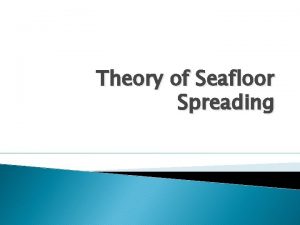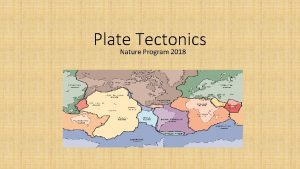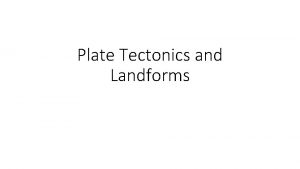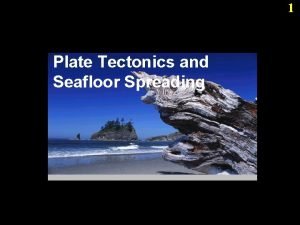Plate Tectonics Seafloor Spreading Seafloor Spreading The one
















- Slides: 16

Plate Tectonics Sea-floor Spreading

Sea-floor Spreading The one problem with Wegner’s theory of continental drift was that scientists could not explain how the continents “drifted”. Wegener’s theory described continents plowing through rigid oceanic crust. Scientist then discovered that new ocean lithosphere is constantly being created at mid-ocean ridges. This became known as sea-floor spreading.

Two pieces of evidence to support sea-floor spreading: 1. Magnetic stripes caused by polarity reversal 2. Ocean floor age

1. Magnetic stripes caused by polarity reversal The Earth has a magnetic field. It is mainly generated in the hot core of the planet and has probably existed throughout most of the Earth's lifetime. The earth’s magnetic field has one North pole and one South pole. By magnetic reversal, or flip, we mean the process by which the North pole is transformed into a South pole and the South pole becomes a North pole.

As a matter of geological record, the Earth's magnetic field has undergone numerous reversals of polarity. We can see this in the magnetic patterns found in volcanic rocks, especially those recovered from the ocean floors. At areas on the ocean floor called mid-ocean ridges, magma is moving to the surface where it cools, hardens, and crystallizes. As it cools, the magnetic elements in the magma orient themselves with the current north and south poles. When the magma has hardened, it moves out from the mid-ocean ridge in both directions like a conveyor belt.

In the last 10 million years, there have been, on average, 4 or 5 reversals. At other times in Earth's history, for example during the Cretaceous era, there have been much longer periods when no reversals occurred. The study of earth’s past magnetic reversals is called the study of paleomagnetism. Reversals are not predictable and are certainly not periodic in nature.

2. Ocean Floor Age The ocean floor has been mapped and aged extensively. Scientists have found that the age of the ocean floor is youngest at the mid-ocean ridges and oldest near the continents. Very little ocean floor is older than 125 million years. Almost all of it has been subducted, carried down into the mantle and recycled.

Because new ocean lithosphere is continually being created but the earth is not growing larger, something must be happening to the older ocean crust. Where the older oceanic crust meets the continental crust, it is being subducted where it melts and becomes part of the asthenosphere again.

Oceanic crust is made of basalt and is denser than continental crust that is made of granite. Because oceanic crust is denser than continental crust, when the two meet as sea-floor spreading occurs, the denser, oceanic crust is subducted, or pushed under the continental crust. Other deformation can occur at these subduction zones. The continental crust can be faulted or folded causing mountains and volcanoes. Also, as the oceanic crust is being subducted, it can cause a deep trench to be formed along the subduction zone.

The process of sea-floor spreading is being run from the heat in the earth’s interior. The heat from the core creates convection currents in the asthenosphere which drives this process. The convection currents act like a conveyor belt that moves the earth’s lithosphere or plates.

So let’s review…. Click on the picture for a video. 1. Magma rises to the surface at mid-ocean ridges where it cools, hardens, and crystallizes. 2. Convection currents from the asthenosphere move oceanic crust out from both sides of the mid-ocean ridge towards the continents. 3. As denser oceanic crust reaches the less dense continental crust, it is subducted where it melts and again becomes part of the asthenosphere.

There are three major mid-ocean ridges on the earth. The first is the mid-Atlantic Ridge which runs down the middle of the Atlantic Ocean. The second is the mid. Indian Ridge which can be divided into the Central. Indian Ridge, the Southeast -Indian Ridge and the Southwest-Indian Ridge. A portion of this ridge extends over Africa and is called the East African Rift. Finally, there is the Pacific-Antarctic Ridge. It has portions called the East Pacific Rise and the Juan de Fuca Ridge.

The portion of the mid-Indian Ridge that extends onto the African continent is called the East African Rift. It is presently located on the continent but as the rift continues to spread, it will eventually become part of the Indian Ocean.

The East African Rift prior to the present time The current East African Rift The future East African Rift as the Red Sea and Indian Ocean fill in the rift valley

The present East African Rift

East African Rift - Now East African Rift – In the future
 Which is one piece of evidence of seafloor spreading?
Which is one piece of evidence of seafloor spreading? What is one piece of evidence of seafloor spreading?
What is one piece of evidence of seafloor spreading? Isochron map of ocean-floor crust worksheet answers
Isochron map of ocean-floor crust worksheet answers Seafloor spreading vocabulary
Seafloor spreading vocabulary What is sea floor spreading? *
What is sea floor spreading? * What are the evidence of seafloor spreading
What are the evidence of seafloor spreading Sea floor diagram
Sea floor diagram Plate tectonics
Plate tectonics Arthur holmes contribution to plate tectonics
Arthur holmes contribution to plate tectonics Harry hess and seafloor spreading
Harry hess and seafloor spreading Seafloor spreading graphic organizer
Seafloor spreading graphic organizer Crack watc
Crack watc Seafloor spreading animation
Seafloor spreading animation Seafloor spreading
Seafloor spreading Seafloor spreading images
Seafloor spreading images Seafloor spreading
Seafloor spreading Seafloor spreading
Seafloor spreading

